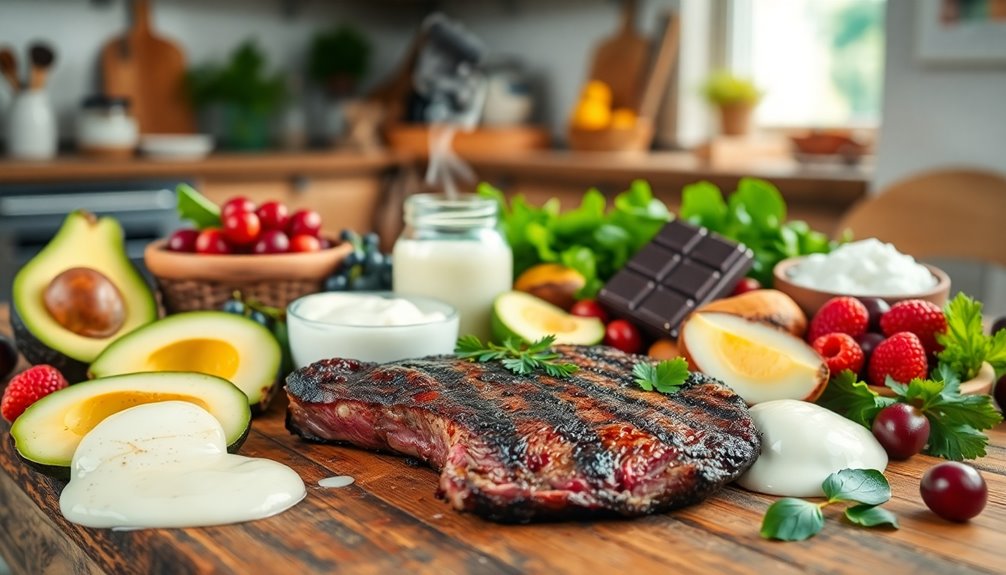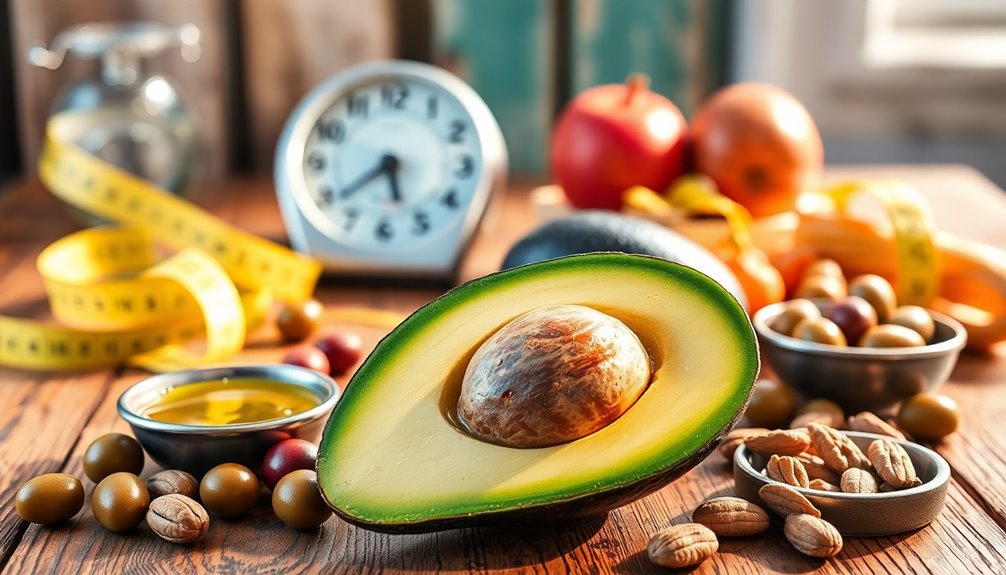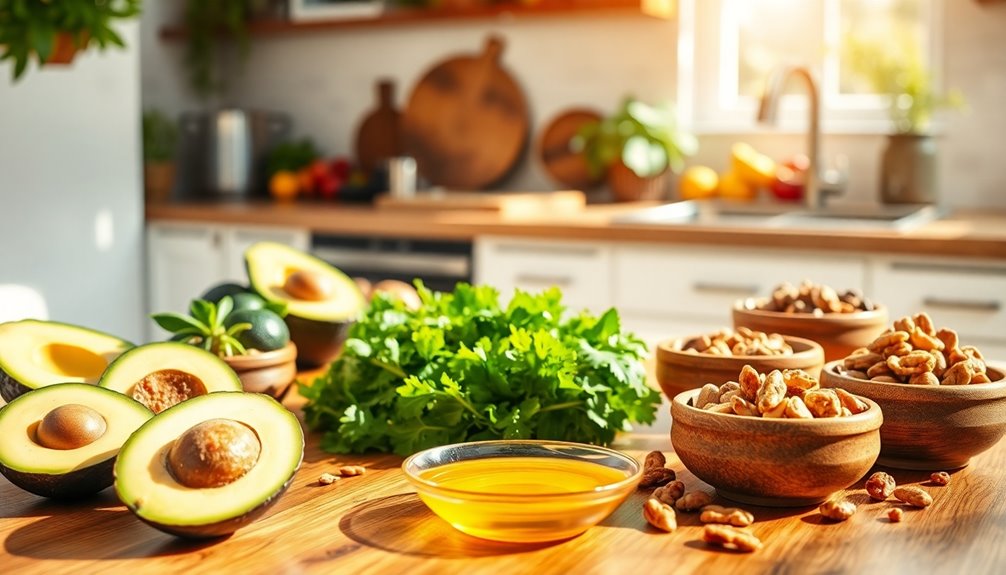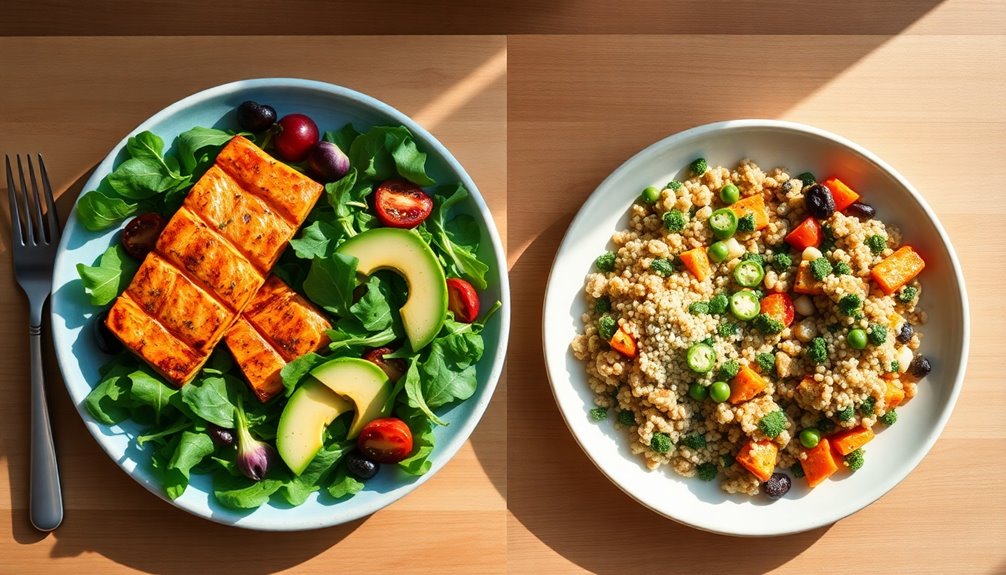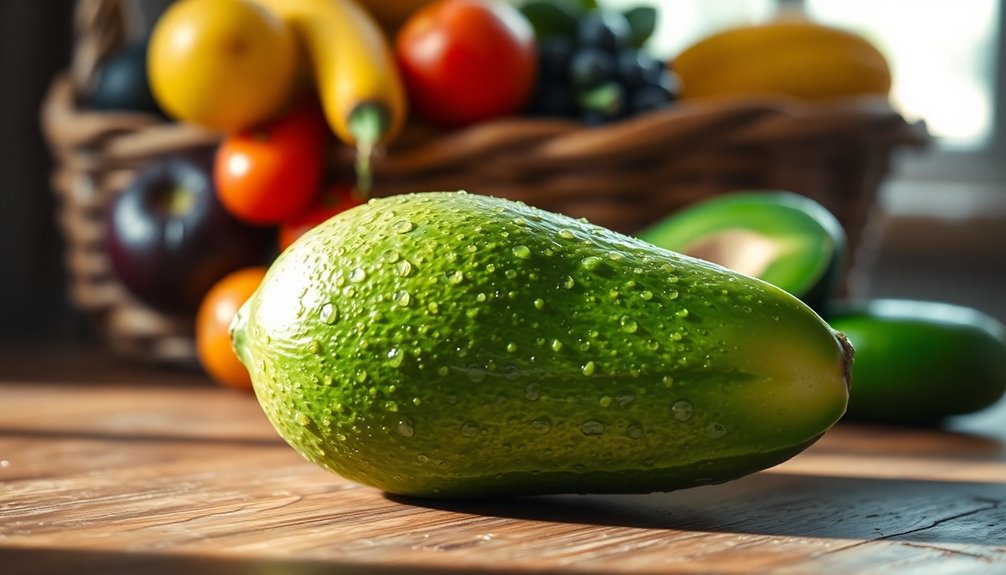Eating fat can actually help you lose weight by enhancing fat oxidation and increasing your sense of fullness. High-fat diets have been shown to reduce calorie intake while preserving lean muscle, making weight loss easier. You'll feel satisfied longer, meaning fewer snacks throughout the day. Plus, these diets offer health benefits, like improved heart health and lower inflammation. However, it's crucial to choose the right fats and maintain a balanced approach. With the right strategies, you can personalize your diet effectively. If you want to unlock more secrets to fat-fueled weight loss, there's so much more to explore!
Key Takeaways
- High-fat diets enhance fat oxidation, promoting weight loss while preserving lean muscle mass and reducing abdominal fat.
- Consuming healthy fats increases satiety, leading to lower overall caloric intake without sacrificing fullness.
- Balanced high-fat diets improve body composition and reduce chronic inflammation, supporting heart health and lowering disease risks.
- Personalize your high-fat meal plan by focusing on nutrient-dense foods and adjusting macros for optimal results.
- Incorporate practical strategies like meal planning and mindful eating to sustain long-term success in fat-fueled weight loss.
Understanding Fat Oxidation
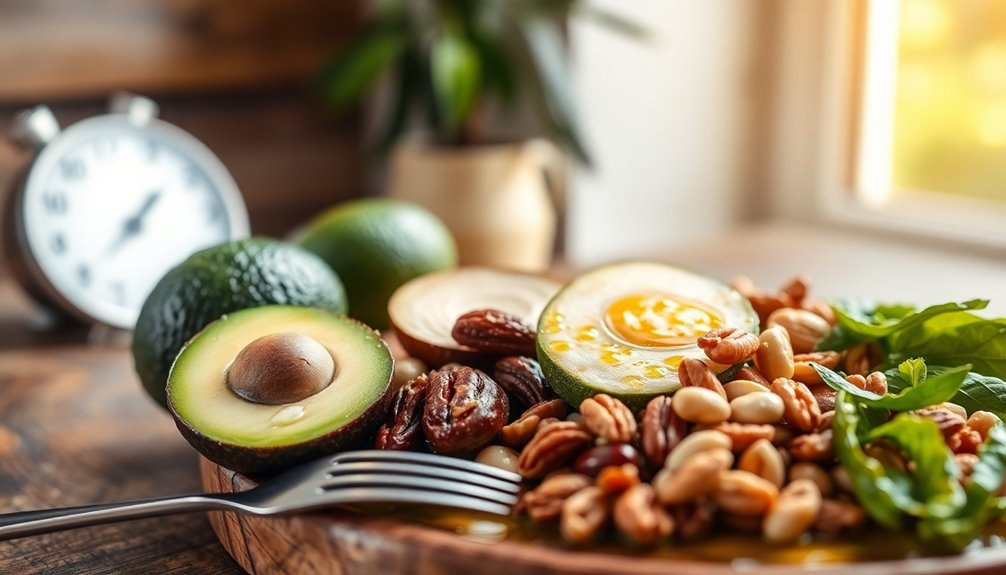
Understanding fat oxidation is crucial for anyone looking to optimize their weight loss journey. This process involves breaking down fats, or triglycerides, into smaller molecules like free fatty acids and glycerol, which your body then uses for energy.
Primarily occurring in the mitochondria of your cells, fat oxidation consists of several steps, including the activation of fatty acids, their transport into the mitochondrial matrix, and beta-oxidation. During beta-oxidation, enzymes work through four key steps to produce 2-carbon acetyl-CoA molecules. These molecules contribute to the citric acid cycle, ultimately generating ATP, NADH, and FADH2, which fuel your body. Oxidation of fats can also lead to nutrient loss, particularly fat-soluble vitamins, which may affect your overall health and energy levels.
Factors like endurance training can enhance your mitochondrial capacity, increasing your ability to oxidize fat efficiently. To further optimize fat oxidation, consider low-intensity training and manage your sleep and stress levels. Hormones like adrenaline play a significant role as well.
Calorie Expenditure Myths

Fat oxidation plays a significant role in weight loss, but many misconceptions surround calorie expenditure that can derail your efforts. One major myth is the 3500-calorie rule, which claims that a pound of fat equals 3500 calories. Research has shown this isn't accurate; cutting 500 calories a day won't always lead to the expected weight loss. In fact, individual responses to calorie cuts can vary significantly, affecting overall weight loss results. Additionally, proper nutrition is vital for fetal development, which underscores the importance of a balanced diet during weight loss. Freelance gigs can also be a good way to fund your health journey while focusing on nutrition.
Your body adapts over time, slowing your metabolism as you lose weight, so the same calorie deficit can yield different results for men, women, and people of various ages.
Moreover, calorie counting isn't as precise as you might think. Apps and calculators often rely on averages, which can misjudge your specific needs. Nutrition labels can even be off by 20%, meaning you mightn't be getting the full picture.
Your body absorbs calories differently too; for example, nuts are metabolized differently than pizza.
Lastly, your body reacts to calorie restriction by slowing down metabolism and altering hormone levels, making weight regain likely after initial losses. Understanding these myths can help you navigate your weight loss journey more effectively and focus on what truly matters—sustaining a balanced, fat-fueled lifestyle.
Weight Loss and High-Fat Diets
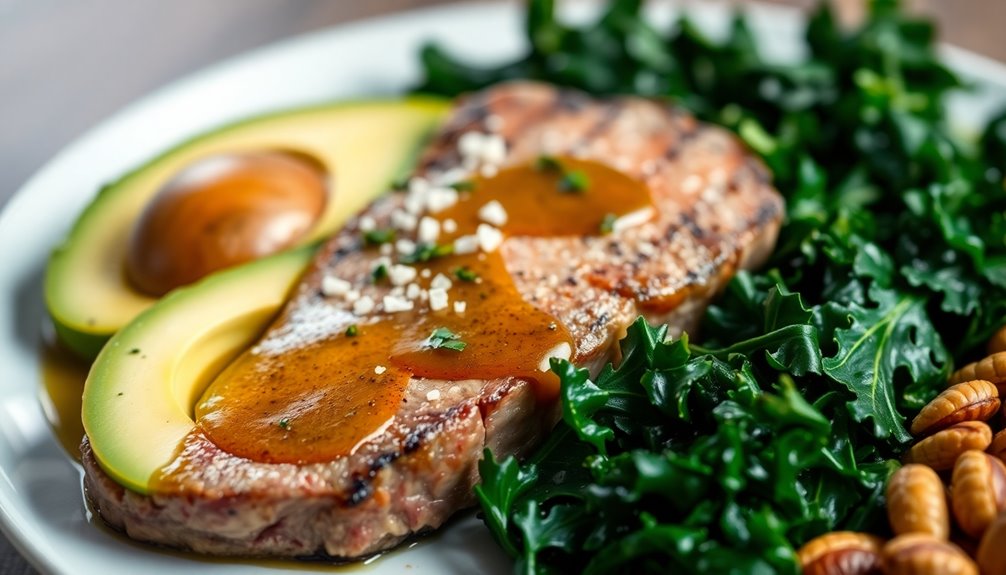
Embracing a high-fat diet can be a game-changer for your weight loss journey. Research shows that such diets can lead to significant weight loss, with some studies reporting a 13.7% reduction in weight over a year. A very low-carbohydrate, high-fat diet (VLCD) can be particularly effective, especially for older adults with obesity, leading to fat loss without intentional calorie restriction.
When you adopt a high-fat diet, your body switches from burning sugar to fat for energy, which can enhance weight loss. This diet not only reduces total fat mass but also preserves lean muscle, improving your overall body composition. It's especially effective at depleting harmful abdominal fat, reducing the risk of cardiometabolic diseases. In fact, studies have shown that a VLCD can lead to improvements in metabolic health, which is crucial for those at risk. Additionally, incorporating high levels of antioxidants from foods like celery juice can support your health during this transition.
Furthermore, high-fat diets can enhance your metabolic health, improving insulin sensitivity and lipid profiles. You might notice reductions in blood pressure and inflammation, which contribute to better overall health.
While it can be challenging to maintain a high-fat diet long-term, the flexibility of incorporating healthy fats into your meals makes it more sustainable. By embracing whole, nutritious foods, you can create a satisfying and effective weight loss plan.
The Role of Satiety
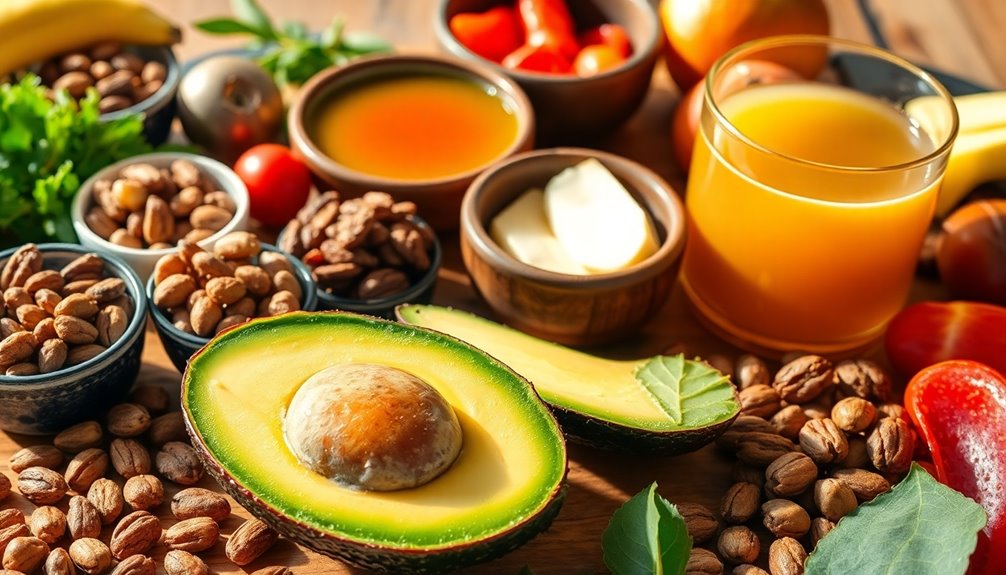
Satiety plays a crucial role in your weight loss journey, especially when following a high-fat diet. High-fat diets can enhance your feeling of fullness due to the slower digestion of fats, leading to a gradual release of free fatty acids in your small intestine. This process helps suppress hunger, allowing you to consume fewer calories overall.
In fact, studies show that individuals on high-fat diets often eat significantly less—about 2200 calories compared to 3100 on mixed diets—while still feeling satisfied. Additionally, the types of fats you consume matter. Polyunsaturated and monounsaturated fatty acids tend to reduce ghrelin levels and boost peptide YY, hormones that signal fullness. Medium-chain triglycerides (MCTs) are particularly effective in improving satiety, aiding weight loss without compromising lean muscle mass. Importantly, studies indicate that high fat diets may enhance feelings of fullness, contributing to lower calorie consumption.
Behaviorally, high-fat diets can change your eating patterns, reducing snacking frequency and delaying hunger cues between meals. While subjective feelings of fullness can vary, many people report greater satiety on these diets.
Health Benefits of High-Fat Diets

A balanced high-fat diet offers numerous health benefits that can significantly enhance your overall well-being. One major advantage is improved body composition. By reducing fat mass and increasing lean muscle, you can achieve a healthier physique over just 16 weeks. This transformation often occurs even without major weight loss, indicating a beneficial redistribution of body fat and muscle. Studies have shown that participants in such diets experienced a significant decrease in fat mass.
Additionally, a high-fat diet can reduce inflammation. It lowers blood levels of inflammatory cytokines, which diminishes chronic inflammation linked to conditions like heart disease and diabetes. These anti-inflammatory effects contribute to better vascular function and overall health. Furthermore, certain types of honey, such as pine honey, have shown remarkable antimicrobial properties that can support immune function.
Your heart health can also benefit from this dietary approach. High-fat, low-carb diets often lead to lower blood pressure and triglyceride levels, significantly reducing your risk of heart disease and stroke. While a single high-fat meal might cause temporary changes, long-term adherence to balanced high-fat eating stabilizes LDL cholesterol levels and improves blood vessel elasticity.
Finally, you'll notice enhanced vascular function. Lower blood pressure and improved red blood cell function help maintain cardiovascular health, reducing the risk of atherosclerosis and heart attacks.
Embracing a balanced high-fat diet can truly transform your health for the better.
Risks of High-Fat Diets
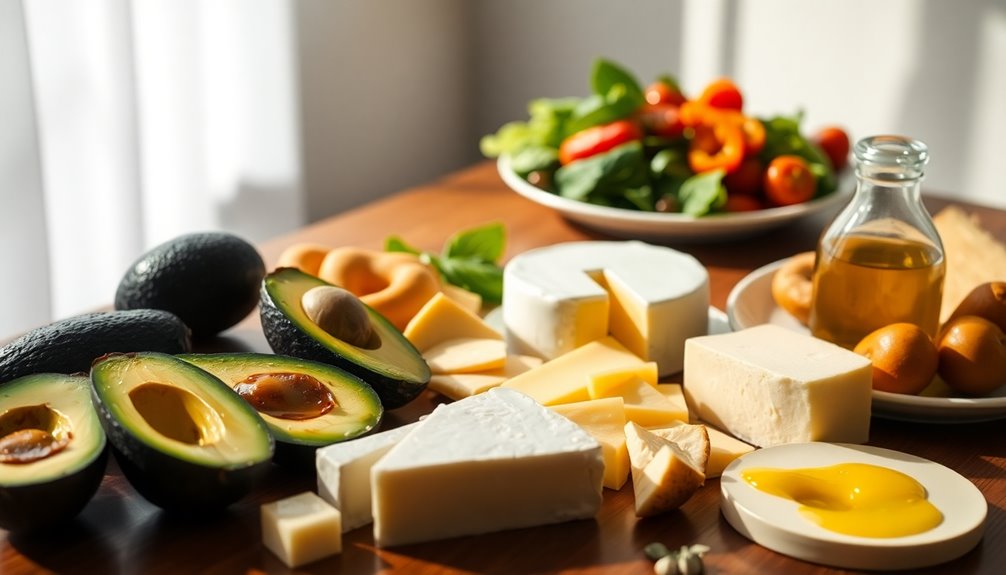
While a high-fat diet can offer several health benefits, it's important to recognize the potential risks that come with it. One major concern is cardiovascular health. Diets high in saturated fat can increase your risk of heart disease, and just one high-fat meal can negatively impact your blood vessels. You'll also see an increase in pro-inflammatory markers, which can contribute to atherosclerosis.
Additionally, your gastrointestinal health may suffer. High-fat diets can elevate the risk of colon cancer by promoting harmful stem cell growth. They also disrupt your gut microbiome, leading to inflammation and increasing chances of inflammatory bowel disease. Notably, these diets have been linked to changes in gene expression related to gut bacteria, which can further exacerbate gastrointestinal issues.
Your immune system isn't immune to these effects either. High-fat diets can impair your body's ability to recognize and respond to infections, potentially increasing susceptibility to illnesses, including COVID-19.
Finally, you might find that these diets lead to increased calorie intake without the promised weight loss. They can cause your body to store fat rather than burn it, disrupting your metabolic health.
Practical Tips for Success
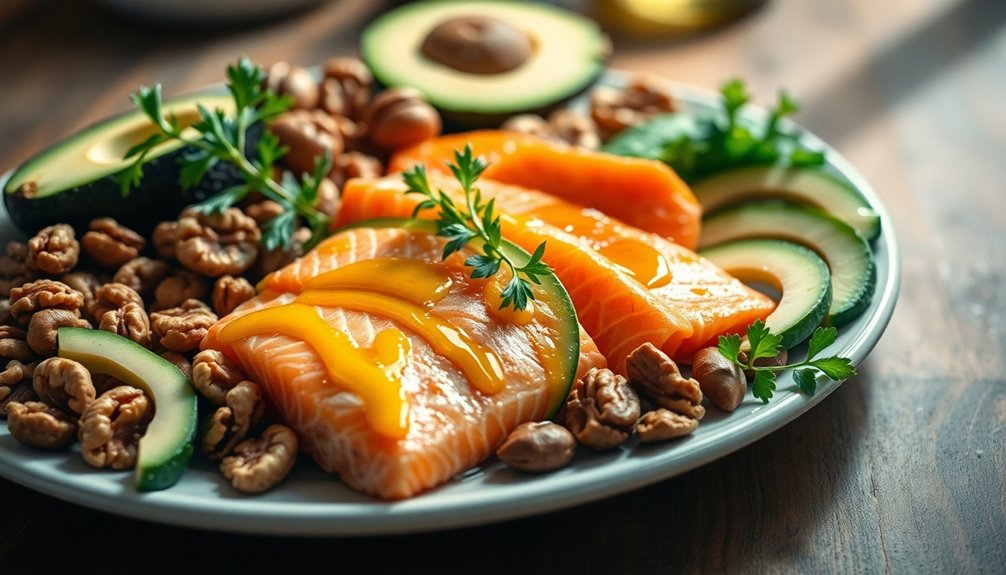
Five practical tips can help you succeed on your fat-fueled weight loss journey.
First, focus on eating healthy, nutrient-dense foods like lean meats, vegetables, and high-quality fats. This will ensure you get the nutrients you need while keeping your calorie intake in check.
Second, limit processed and high-calorie foods; avoiding added sugars and unhealthy fats will make a significant difference. Identifying trigger foods can also help you minimize temptation and manage cravings more effectively.
Third, aim for 1.5 grams of protein per kilogram of your body weight. Spread your protein intake across meals and snacks to support muscle maintenance and satiety.
Fourth, watch your portion sizes. Reducing portions of calorie-dense foods can help lower your overall calorie intake without feeling deprived.
Lastly, keep a food and fitness diary. Tracking what you eat and how you exercise can double your fat loss efforts and promote mindful eating.
Meal planning is essential, so stock up on nutritious foods and prep meals in advance. By implementing these practical tips, you'll create a solid foundation for success on your fat-fueled weight loss journey.
Stay focused, and remember that small, consistent changes lead to lasting results.
Personalizing Your Diet Plan
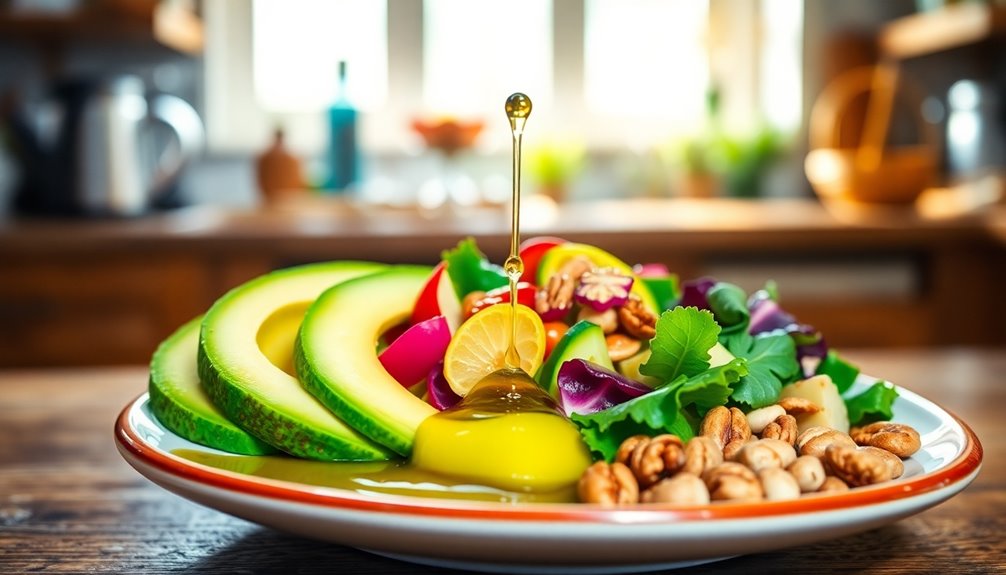
Personalizing your diet plan is crucial for achieving lasting success in your fat-fueled weight loss journey. Start by creating a customized meal plan tailored to your individual needs. Break down your daily intake into specific macros—calories, fat, protein, and carbs—so you know exactly what you're consuming. Including low-carb vegetables can enhance your fiber intake, supporting overall health.
Flexibility is key; allow yourself meal swaps and choose recipes that excite you. Additionally, consider incorporating related products that can enhance your meal planning experience and provide variety in your dietary options.
Focus on smart food choices by limiting non-nutritious items like sugars and high-fat snacks. Opt for lean proteins such as poultry, fish, and legumes, and incorporate low-fat dairy options. Understanding the principles of the Law of Attraction can also help you maintain a positive mindset throughout your journey.
Don't forget to include plenty of fruits and vegetables, whole grains, and stay hydrated. Aim for 25g of fiber daily to support gut health on keto, which can help with weight loss.
Support is essential. Consider 1:1 coaching with a nutritionist for personalized guidance. Use food diaries and trackers to monitor your intake and progress, and engage with community support for motivation.
Regular check-ins will help keep you accountable and on track.
Frequently Asked Questions
Can I Eat Any Type of Fat on a High-Fat Diet?
Yes, you can eat different types of fats on a high-fat diet, but focus on healthier options.
Include monounsaturated fats from sources like avocados and olive oil, as they support heart health.
Polyunsaturated fats, particularly omega-3s from fatty fish, are also beneficial.
Limit saturated fats found in fatty meats and avoid trans fats completely.
Balancing these fats will help you maintain a healthy diet while enjoying your meals.
How Do I Track My Fat Intake Accurately?
To track your fat intake accurately, start by keeping a detailed food record for a few days, noting everything you eat and drink.
Use nutrition labels on packaged foods to check serving sizes and fat content. Consider utilizing apps like MyFitnessPal to log your meals easily.
Weigh and measure portions when possible, and remember to adjust your estimates, as people often underestimate their intake by about 10-20%.
Consistency is key!
Will I Experience Keto Flu on a High-Fat Diet?
Yes, you might experience keto flu when starting a high-fat diet.
As your body shifts from burning carbs to using fat and ketones for energy, you could face symptoms like headache, fatigue, and dizziness. This adjustment period can last from a few days to weeks.
Staying hydrated and balancing your electrolytes can help ease these symptoms.
Just remember, they're typically temporary as your body adapts to the new fuel source.
Can I Combine High-Fat and Low-Carb Diets Effectively?
Absolutely, you can combine high-fat and low-carb diets effectively!
By focusing on low-carb foods and increasing your healthy fat intake, you'll likely experience reduced hunger and cravings.
You'll find that this combination can enhance your weight loss efforts while providing essential nutrients.
Just ensure you stick to whole, nutritious foods like avocados, nuts, and leafy greens to maximize benefits and maintain your energy levels throughout the process.
How Long Does It Take to See Results on a High-Fat Diet?
You can typically see initial results on a high-fat diet within the first week, primarily due to fluid and glycogen loss.
After about four to six weeks, you might notice a more gradual weight loss as your body shifts to burning fat for energy.
However, remember that individual responses vary based on factors like your activity level and starting weight, so patience is key in achieving sustainable results over time.
Conclusion
By embracing a high-fat diet, you can fuel your body, enhance satiety, and potentially shed those extra pounds. Remember, it's all about balance and understanding your unique needs. While there are health benefits, keep an eye on potential risks. Personalize your plan to fit your lifestyle, and don't hesitate to experiment. You've got the tools to succeed, so trust your journey and enjoy the process of eating fat and losing weight!
